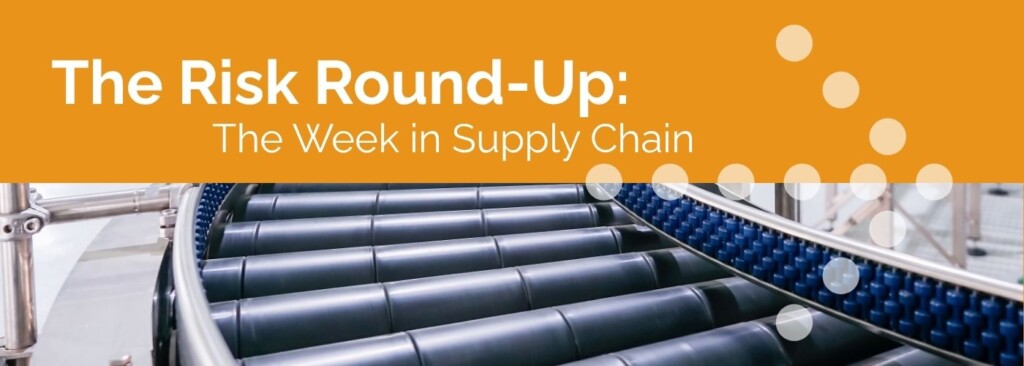
This week’s supply chain risk news
New tariff exemptions are on the table for countries willing to bargain
A new executive order on President Donald Trump’s tariffs includes key exemptions on metals, generic pharmaceuticals, aircraft parts, and agricultural products. Those apply to countries that have reached updated deals with the U.S., as Politico reports, and could help draw others to the bargaining table.
The tariffs, we’ve noted before, have complicated international shipping and supply chains—and have contributed to a months-long downturn in global trade.
The executive order is welcome news for trade partners that have recently worked out deals, like the EU, Japan, and South Korea. The exemptions include tungsten, gold, graphite, uranium, and a long list of other products.
One thing to remember: The U.S. Supreme Court is now set to give Trump’s tariffs a hard look in early November. If the court decides the president overstepped his authority by imposing the tariffs and undoes them, the U.S. could have to pay back tens of billions of dollars it’s already collected.
Beijing made solar too cheap for the competition. Could the same happen with chips?
Semiconductors are critical for anyone who builds or relies on phones, data centers, or modern cars—which is to say, almost everyone. In this space, China is ratcheting up its influence. That’s partly with intense military posturing that could affect manufacturers in Taiwan, as we noted late last month, and also because Beijing is making moves “to dominate the market for chip-grade polysilicon,” per a report from the Information Technology & Innovation Foundation.
Polysilicon comes in different purities, and for years, the Chinese government has used subsidies, incentives, and other support to bolster firms producing solar-grade polysilicon, driving down prices and undercutting competitors elsewhere. They’ve been so successful, in fact, that talks are now underway to dial back solar production to curb overcapacity.
To make semiconductors, you need purer polysilicon, and to scale economically, it’s best to pair this with solar-grade production. This, the report contends, means the same playbook that’s made it tough for the U.S. to compete on solar prices could, in turn, strengthen China’s hand on semiconductors.
Count the Trump administration among those interested; it’s now investigating the national security implications of polysilicon imports.
We’re halfway through another hurricane season, two decades after Katrina
When Hurricane Katrina crashed into Louisiana 20 years ago, it marked one of this century’s defining catastrophes; 1,836 people died. The costliest hurricane in history, with an impact around $167 billion, Katrina also exposed vulnerabilities in national and global supply chains. Its lessons forced significant changes in supply chain risk management. Improved contingency planning and other practices that trace to the storm are still worth studying and refining today.
Mid-September marks peak Atlantic hurricane season—a period of heightened risk of tropical supply chain disruptions. In terms of accumulated cyclone energy, or ACE, this year has already been above average, given six tropical storms and the category 5 hurricane Erin, which thankfully never made landfall.
So far, this aligns broadly with our outlook from May, when we predicted elevated risk from hurricanes, but nothing close to 2024—one of the costliest seasons on record. Still, as we discuss on our blog, late September and early October could be more active. Sea-surface temperatures (SSTs) are higher than usual in parts of the Atlantic and especially in the Gulf of Mexico, which could fuel sizable storms. The season is far from over.
Passenger jet production is throttling up
Ever since air travel came roaring back after the pandemic, the airline industry has struggled to maintain supplies of passenger jets—that is, until recently.
Thanks to easing supply chain snarls and improving output, Bloomberg says carriers may soon be getting enough planes to retire more aging aircraft. The overall fleet of single-aisle planes could grow by some 9.5 percent next year, experts say.
That, in turn, points toward a notable shift. Only about 2 percent of airlines’ passenger planes were retired last year—less than the year before or the 2.5 percent historical average. And companies have been paying dearly for maintenance and spare parts to keep more old jets in the air, as Bloomberg observes: “Demand in this corner of the aerospace market is unlikely to crater but it may be due for a normalization, particularly as domestic travel falls short of expectations and US airlines wrestle with a surplus of available seats.”
If that last bit about empty seats sounds downbeat, it might not be all bad. Lower chances of a kid kicking the back of your chair for half of your next flight, after all.
